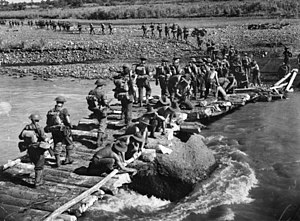Battle of Dumpu
| Battle of Dumpu | |||||||
|---|---|---|---|---|---|---|---|
| Part of the Markham and Ramu Valley – Finisterre Range campaign, World War II | |||||||
 Australian troops cross a bridge over the 10-knot (19 km/h) Gusap River on 25 October 1943 |
|||||||
|
|||||||
| Belligerents | |||||||
|
|
|||||||
| Commanders and leaders | |||||||
|
|
|
||||||
| Units involved | |||||||
| 21st Brigade | 78th Infantry Regiment | ||||||
| Casualties and losses | |||||||
| 5 dead 8 wounded 119 sick |
unknown | ||||||
The Battle of Dumpu was an action fought in September and October 1943 between Australian and Japanese forces in New Guinea during the Markham and Ramu Valley – Finisterre Range campaign of World War II. After the Battle of Kaiapit on 20 September 1943, in which the 2/6th Independent Company won a stunning victory against a numerically superior Japanese force, Ivan Dougherty's 21st Infantry Brigade of the 7th Division advanced from Kaiapit to Dumpu in the Ramu Valley. During the entire advance, the Australian and American forces in the Ramu Valley were supplied by air. The capture of the Ramu Valley allowed a forward airbase to be developed at Gusap.
The Markham Valley is part of a flat, elongated depression varying from 8 to 32 kilometres (5.0 to 19.9 mi) wide that cuts through the otherwise mountainous terrain of the interior of New Guinea, running from the mouth of the Markham near the port of Lae, to that of the Ramu some 600 kilometres (370 mi) away. The two rivers flow in opposite directions, separated by an invisible divide about 130 kilometres (81 mi) from Lae. The area is flat and suitable for airstrips, although it is intercut by many tributaries of the two main rivers. The area around the divide was the largest area in New Guinea bereft of forest cover, and was passable by vehicles. Between the Ramu Valley and Madang lay the rugged and aptly named Finisterre Ranges.
In the wake of the landing at Nadzab on 5 September 1943, and the subsequent capture of Lae on 16 September 1943, Major General George Alan Vasey's 7th Division moved on to the next task assigned by the Commander in Chief, South West Pacific Area, General Douglas MacArthur, in the June 1943 directive that outlined Operation Cartwheel. This entailed protecting the area it had secured around Nadzab to allow airfields to be developed there, along with the existing airfields around Goroka and Bena Bena.
...
Wikipedia
